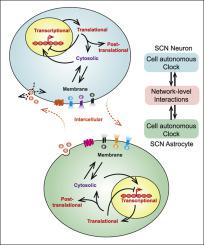当前位置:
X-MOL 学术
›
J. Mol. Biol.
›
论文详情
Our official English website, www.x-mol.net, welcomes your
feedback! (Note: you will need to create a separate account there.)
Molecular-genetic Manipulation of the Suprachiasmatic Nucleus Circadian Clock.
Journal of Molecular Biology ( IF 4.7 ) Pub Date : 2020-01-26 , DOI: 10.1016/j.jmb.2020.01.019 Michael H Hastings 1 , Nicola J Smyllie 1 , Andrew P Patton 1
Journal of Molecular Biology ( IF 4.7 ) Pub Date : 2020-01-26 , DOI: 10.1016/j.jmb.2020.01.019 Michael H Hastings 1 , Nicola J Smyllie 1 , Andrew P Patton 1
Affiliation

|
Circadian (approximately daily) rhythms of physiology and behaviour adapt organisms to the alternating environments of day and night. The suprachiasmatic nucleus (SCN) of the hypothalamus is the principal circadian timekeeper of mammals. The mammalian cell-autonomous circadian clock is built around a self-sustaining transcriptional-translational negative feedback loop (TTFL) in which the negative regulators Per and Cry suppress their own expression, which is driven by the positive regulators Clock and Bmal1. Importantly, such TTFL-based clocks are present in all major tissues across the organism, and the SCN is their central co-ordinator. First, we analyse SCN timekeeping at the cell-autonomous and the circuit-based levels of organisation. We consider how molecular-genetic manipulations have been used to probe cell-autonomous timing in the SCN, identifying the integral components of the clock. Second, we consider new approaches that enable real-time monitoring of the activity of these clock components and clock-driven cellular outputs. Finally, we review how intersectional genetic manipulations of the cell-autonomous clockwork can be used to determine how SCN cells interact to generate an ensemble circadian signal. Critically, it is these network-level interactions that confer on the SCN its emergent properties of robustness, light-entrained phase and precision- properties that are essential for its role as the central co-ordinator. Remaining gaps in knowledge include an understanding of how the TTFL proteins behave individually and in complexes: whether particular SCN neuronal populations act as pacemakers, and if so, by which signalling mechanisms, and finally the nature of the recently discovered role of astrocytes within the SCN network.
中文翻译:

超视交叉核生物钟的分子遗传操纵。
生理和行为的昼夜节律(昼夜节律)使生物适应昼夜交替的环境。下丘脑的视交叉上核(SCN)是哺乳动物的主要生物钟。哺乳动物细胞自治生物钟围绕自我维持的转录-翻译负反馈回路(TTFL)构建,其中负调节剂Per和Cry抑制其自身表达,这由正调节剂Clock和Bmal1驱动。重要的是,这种基于TTFL的时钟存在于整个生物体的所有主要组织中,而SCN是它们的中心协调器。首先,我们在单元自治和基于电路的组织级别分析SCN计时。我们考虑如何使用分子遗传学的手段来探究SCN中的细胞自主计时,确定时钟的组成部分。其次,我们考虑了能够实时监控这些时钟组件和时钟驱动的蜂窝输出活动的新方法。最后,我们回顾了如何使用细胞自主发条的交叉遗传操作来确定SCN细胞如何相互作用以产生整体昼夜节律信号。至关重要的是,正是这些网络级的交互作用赋予了SCN其鲁棒性,光夹带相位和精度特性的新兴特性,这些特性对于它作为中央协调者至关重要。剩下的知识空白包括对TTFL蛋白如何单独和复杂发挥作用的理解:特定的SCN神经元群体是否起起搏器的作用;如果是,起何种信号传导机制的作用,
更新日期:2020-01-26
中文翻译:

超视交叉核生物钟的分子遗传操纵。
生理和行为的昼夜节律(昼夜节律)使生物适应昼夜交替的环境。下丘脑的视交叉上核(SCN)是哺乳动物的主要生物钟。哺乳动物细胞自治生物钟围绕自我维持的转录-翻译负反馈回路(TTFL)构建,其中负调节剂Per和Cry抑制其自身表达,这由正调节剂Clock和Bmal1驱动。重要的是,这种基于TTFL的时钟存在于整个生物体的所有主要组织中,而SCN是它们的中心协调器。首先,我们在单元自治和基于电路的组织级别分析SCN计时。我们考虑如何使用分子遗传学的手段来探究SCN中的细胞自主计时,确定时钟的组成部分。其次,我们考虑了能够实时监控这些时钟组件和时钟驱动的蜂窝输出活动的新方法。最后,我们回顾了如何使用细胞自主发条的交叉遗传操作来确定SCN细胞如何相互作用以产生整体昼夜节律信号。至关重要的是,正是这些网络级的交互作用赋予了SCN其鲁棒性,光夹带相位和精度特性的新兴特性,这些特性对于它作为中央协调者至关重要。剩下的知识空白包括对TTFL蛋白如何单独和复杂发挥作用的理解:特定的SCN神经元群体是否起起搏器的作用;如果是,起何种信号传导机制的作用,











































 京公网安备 11010802027423号
京公网安备 11010802027423号